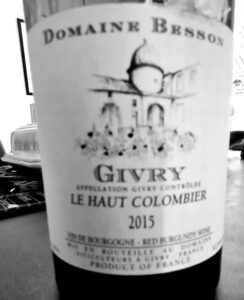norman.comfort@getcomfortable.co.uk, or talk to me on 07530 708125. Let's do this.....
Domaine Besson, Pinot Noir 2015, Le Haut Colombier, Givry.
This is an exceptional example of a Pinot Noir. A 2015 vintage still tasting fresh with the acidity holding up well and complexity coming through from bottle aging.
On the eye: pale ruby
On the nose: pronounced, we find red cherry, redcurrant, raspberry, red plum, blackberry, fennel, dried herbs, liquorice, cinnamon, leather, earth, mushroom, fig and prune.
On the pallet: dry with medium plus acidity, medium alcohol, a full body with pronounced flavours as found on the nose. The tannins are medium plus and are smooth, soft and ripe. The wine has a long finish.
This wine is outstanding in quality. The aromas found on the nose are intriguing and complex. The wine has tertiary characteristics, yet the acidity is refreshing and ensures primary fruit flavours such as redcurrant and red cherry still shine through. The tannins are soft and perfectly integrated into the wine. The alcohol, tannins and acidity form a perfect balance. The wine has great complexity and intensity of flavour showing pronounced primary fruit flavours alongside the results of bottle aging adding tertiary notes such as mushroom and prune. The finish is long and complex allowing the drinker to savour this wine at a slow pace.
What are the wine making techniques that make this wine so outstanding?
- Grapes are de-stemmed. De-stemming grapes removes both the tannins and astringent flavours found in the stems of grape bunches.
- Fermentation is at 28 – 30 degrees Celsius, with just a few gentle punch downs over 8 to 10 days. This is a relatively warm fermentation, meaning extraction of phenolics and tannins will be maximised. Undertaking just a few punch downs will slow the fermentation down increasing complexity of flavours both from the juice and from fermentation itself. However, punch downs do increase extraction of flavours, tannins and colour, so doing just a few is a stylistic and intentional choice made in conjunction with the decision to ferment at 28 – 30 degrees Celsius.
- Element of whole punch fermentation. If whole bunches of grapes are added into the juice, there can be an element of intracellular fermentation. This is an anaerobic fermentation that happens inside an intact, uncrushed grape that causes it to break down on its own. This produces additional flavours such as lighter red fruits like strawberries and red cherries and even a hint of bubblegum. Additionally, the stems absorb some of the colour pigment making the wines lighter in colour.
- Aging is carried out in 50% new oak for at least 12 months without racking. Oak aging provides three things for a wine:
- 1) flavours from the oak are imparted into the wine, such as clove, cinnamon, smoke and coconut.
- 2) micro oxygenation occurs stabilizing the colour of the wine, breaking down harsher tannings and making the wines mouth feel less astringent.
- 3) If malolactic conversion has not taken place during the fermentation it can happen in this environment as can other subtle chemical reactions. During this time there is no racking, which means dead yeast cells known as lees will add mouth feel and texture to the wine as they are slowly broken down and absorbed into the wine.
- Blending wines from different parcels of land and/or wines aged in different oak barrels (new or old) can give the wine an intended style, more consistency over vintages, and more complexity. Some people refer to this as “designing the wine” – taking the best of various wine pressings and combining them in the right proportions to make something even better.

